Omnicell UPEK Sensor User manual

Touch & Go™ Technical Guide for UPEK Sensor Model
67-3090 Rev A
Biometric Fingerprint Scanner Hardware Installation, Service, and Software Implementation for Omnicell 15.0 and higher

This guide is CONFIDENTIAL and designed only for Omnicell Technical personnel and/or designated representatives.
This guide and accompanying software and/or hardware described in it are protected under copyright laws and may not be copied, wholly or in part, without the express written consent of Omnicell, Inc. The same proprietary and copyright notices must be attached to any permitted copies as were attached to the original documents.
Omnicell, Inc.
1201 Charleston Road Mountain View, CA 94043 (650) 251-6100 www.omnicell.com
Omnicell and the Omnicell design mark, OmniBuyer, OmniCenter, OmniRx, OmniSupplier, Pandora, PandoraVIA, SafetyMed, SafetyStock, and Sure-Med are registered trademarks. Anesthesia TT, Anesthesia Workstation, Anywhere RN, Executive Advisor, FlexBin, Medication Surveillance, OmniDispenser, OmniLinkRx, OmniScanner, OmniTrack, Omni TT, Open Touch, OptiFlex, OptiFlex MobileTrack, Point-to-Point Medication Safety, ProServ1, SecureVault, See & Touch, SinglePointe, TempCheck, Touch & Go, vSuite, and WorkflowRx are trademarks of Omnicell, Inc. in the United States and internationally. All other trademarks and trade names are the property of their respective owners.
Copyright 1999-2011 Omnicell, Inc. All rights reserved.
Touch & Go™ Technical Guide for UPEK Sensor Model/67-3090 Rev A |
© 2011 Omnicell, Inc. |

iii
Table of Contents
Preface. . . . . . . . . . . . . . . . . . . . . . . . . . . . . . . . . . . . . . . . . . . . . . . . . . . . . . . . . . . . . . . . . . . . . . ii-1
How to Use this Manual . . . . . . . . . . . . . . . . . . . . . . . . . . . . . . . . . . . . . . . . . . . . . . . . . . . . . . . ii-1
Where to Locate Related Information . . . . . . . . . . . . . . . . . . . . . . . . . . . . . . . . . . . . . . . . . . ii-1
Introduction to Touch & Go. . . . . . . . . . . . . . . . . . . . . . . . . . . . . . . . . . . . . . . . . . . . . . . . . . . . 1-1
Hardware Overview . . . . . . . . . . . . . . . . . . . . . . . . . . . . . . . . . . . . . . . . . . . . . . . . . . . . . . . . . . 1-2
Fingerprints . . . . . . . . . . . . . . . . . . . . . . . . . . . . . . . . . . . . . . . . . . . . . . . . . . . . . . . . . . . . . . . . . 1-3 Fingerprint Security . . . . . . . . . . . . . . . . . . . . . . . . . . . . . . . . . . . . . . . . . . . . . . . . . . . . . . . . . . 1-3 User Authentication . . . . . . . . . . . . . . . . . . . . . . . . . . . . . . . . . . . . . . . . . . . . . . . . . . . . . . . . . . 1-4
Single-factor Authentication Mode . . . . . . . . . . . . . . . . . . . . . . . . . . . . . . . . . . . . . . . . . . 1-4 Two-factor with Fingerprint Authentication Mode. . . . . . . . . . . . . . . . . . . . . . . . . . . . . 1-5 Two-factor with Password Authentication Mode . . . . . . . . . . . . . . . . . . . . . . . . . . . . . . 1-5 Fingerprint Enrollment . . . . . . . . . . . . . . . . . . . . . . . . . . . . . . . . . . . . . . . . . . . . . . . . . . . . . . . 1-5
Fingerprint Reports . . . . . . . . . . . . . . . . . . . . . . . . . . . . . . . . . . . . . . . . . . . . . . . . . . . . . . . . . . 1-6 System Requirements/Compatibility . . . . . . . . . . . . . . . . . . . . . . . . . . . . . . . . . . . . . . . . . . . 1-6
User Instructions . . . . . . . . . . . . . . . . . . . . . . . . . . . . . . . . . . . . . . . . . . . . . . . . . . . . . . . . . . . . . 1-7
Installing a Fingerprint Scanner on a 1-, 2-, and 3-Cell . . . . . . . . . . . . . . . . . . . . . . . . . . . 2-1
Install the Fingerprint Scanner . . . . . . . . . . . . . . . . . . . . . . . . . . . . . . . . . . . . . . . . . . . . . . . . 2-1
Installing a Fingerprint Scanner on an OmniRx. . . . . . . . . . . . . . . . . . . . . . . . . . . . . . . . . . 3-1
Remove the Omni Rx Keyboard. . . . . . . . . . . . . . . . . . . . . . . . . . . . . . . . . . . . . . . . . . . . . . . . 3-1
Install the Fingerprint Scanner . . . . . . . . . . . . . . . . . . . . . . . . . . . . . . . . . . . . . . . . . . . . . . . . 3-3
Installing a Fingerprint Scanner on an AWS . . . . . . . . . . . . . . . . . . . . . . . . . . . . . . . . . . . . . 4-1
Remove the AWS Keyboard . . . . . . . . . . . . . . . . . . . . . . . . . . . . . . . . . . . . . . . . . . . . . . . . . . . 4-1
Install the Fingerprint Scanner . . . . . . . . . . . . . . . . . . . . . . . . . . . . . . . . . . . . . . . . . . . . . . . . 4-3
Planning for Touch & Go . . . . . . . . . . . . . . . . . . . . . . . . . . . . . . . . . . . . . . . . . . . . . . . . . . . . . . 5-1
Gather Account Information . . . . . . . . . . . . . . . . . . . . . . . . . . . . . . . . . . . . . . . . . . . . . . . . . . 5-1
Review of Policies and Procedures. . . . . . . . . . . . . . . . . . . . . . . . . . . . . . . . . . . . . . . . . . . . . . 5-1
Review New Features . . . . . . . . . . . . . . . . . . . . . . . . . . . . . . . . . . . . . . . . . . . . . . . . . . . . . . . . . 5-2
© 2011 Omnicell, Inc. |
Touch & Go™ Technical Guide for UPEK Sensor Model/67-3090 Rev A |

iv Table of Contents
Develop a Rollout Plan. . . . . . . . . . . . . . . . . . . . . . . . . . . . . . . . . . . . . . . . . . . . . . . . . . . . . . . . 5-2
Discuss Fingerprint Options . . . . . . . . . . . . . . . . . . . . . . . . . . . . . . . . . . . . . . . . . . . . . . . . 5-2
Determine Best User Authentication Mode . . . . . . . . . . . . . . . . . . . . . . . . . . . . . . . . . . . 5-3
Configure Settings Based on Best Practices. . . . . . . . . . . . . . . . . . . . . . . . . . . . . . . . . . . . 5-3
Setting Up OmniCenter . . . . . . . . . . . . . . . . . . . . . . . . . . . . . . . . . . . . . . . . . . . . . . . . 5-3
Configure Color Touch Cabinets . . . . . . . . . . . . . . . . . . . . . . . . . . . . . . . . . . . . . . . . 5-3
Demonstrate Use. . . . . . . . . . . . . . . . . . . . . . . . . . . . . . . . . . . . . . . . . . . . . . . . . . . . . . . . . . 5-4
Determine Fingerprint Registrars. . . . . . . . . . . . . . . . . . . . . . . . . . . . . . . . . . . . . . . . . . . . 5-4
Train Users. . . . . . . . . . . . . . . . . . . . . . . . . . . . . . . . . . . . . . . . . . . . . . . . . . . . . . . . . . . . . . . 5-4
Go Live . . . . . . . . . . . . . . . . . . . . . . . . . . . . . . . . . . . . . . . . . . . . . . . . . . . . . . . . . . . . . . . . . . . . . . 5-4
Setting Up OmniCenter . . . . . . . . . . . . . . . . . . . . . . . . . . . . . . . . . . . . . . . . . . . . . . . . . . . . . . . 6-1
Setting Up Fingerprint Registrar . . . . . . . . . . . . . . . . . . . . . . . . . . . . . . . . . . . . . . . . . . . . . . . 6-1
Setting Up Global Fingerprint Registrars . . . . . . . . . . . . . . . . . . . . . . . . . . . . . . . . . . . . . 6-2
Modifying the FP Registrar for Individual Users. . . . . . . . . . . . . . . . . . . . . . . . . . . . . . . . . 6-3 Setting Up FP Exempt . . . . . . . . . . . . . . . . . . . . . . . . . . . . . . . . . . . . . . . . . . . . . . . . . . . . . . . . 6-3 User Biometrics . . . . . . . . . . . . . . . . . . . . . . . . . . . . . . . . . . . . . . . . . . . . . . . . . . . . . . . . . . . . . . 6-4 Configure Biometric Archiving Setup . . . . . . . . . . . . . . . . . . . . . . . . . . . . . . . . . . . . . . . . 6-6
Setting Up Color Touch Cabinets . . . . . . . . . . . . . . . . . . . . . . . . . . . . . . . . . . . . . . . . . . . . . . . 7-1
Configure Cabinets from OmniCenter. . . . . . . . . . . . . . . . . . . . . . . . . . . . . . . . . . . . . . . . . . 7-2
Configure Cabinets Based on Best Practice. . . . . . . . . . . . . . . . . . . . . . . . . . . . . . . . . . . . . . 7-2 Enable Touch & Go. . . . . . . . . . . . . . . . . . . . . . . . . . . . . . . . . . . . . . . . . . . . . . . . . . . . . . . . 7-2 Shortlist Configurations . . . . . . . . . . . . . . . . . . . . . . . . . . . . . . . . . . . . . . . . . . . . . . . . . . . . 7-2 Inactivity Aging . . . . . . . . . . . . . . . . . . . . . . . . . . . . . . . . . . . . . . . . . . . . . . . . . . . . . . . 7-3 Other Modifications . . . . . . . . . . . . . . . . . . . . . . . . . . . . . . . . . . . . . . . . . . . . . . . . . . . . . . . 7-4 Exempt User Configurations . . . . . . . . . . . . . . . . . . . . . . . . . . . . . . . . . . . . . . . . . . . . 7-4 Fingerprint Help . . . . . . . . . . . . . . . . . . . . . . . . . . . . . . . . . . . . . . . . . . . . . . . . . . . . . . 7-4 Password Entry . . . . . . . . . . . . . . . . . . . . . . . . . . . . . . . . . . . . . . . . . . . . . . . . . . . . . . . 7-5 Other Configurations . . . . . . . . . . . . . . . . . . . . . . . . . . . . . . . . . . . . . . . . . . . . . . . . . . . . . . 7-6
Fingerprint Activity . . . . . . . . . . . . . . . . . . . . . . . . . . . . . . . . . . . . . . . . . . . . . . . . . . . . . . . 7-7
Scanner Maintenance. . . . . . . . . . . . . . . . . . . . . . . . . . . . . . . . . . . . . . . . . . . . . . . . . . . . . . . . . 8-1
Cleaning the Scanner . . . . . . . . . . . . . . . . . . . . . . . . . . . . . . . . . . . . . . . . . . . . . . . . . . . . . . . . . 8-1
Sensor Diagnostics . . . . . . . . . . . . . . . . . . . . . . . . . . . . . . . . . . . . . . . . . . . . . . . . . . . . . . . . . . . 8-1
UPEK Sensor Calibration Utility . . . . . . . . . . . . . . . . . . . . . . . . . . . . . . . . . . . . . . . . . . . . 8-2
Fingerprint Diagnostics . . . . . . . . . . . . . . . . . . . . . . . . . . . . . . . . . . . . . . . . . . . . . . . . . . . . 8-3
Training Customers. . . . . . . . . . . . . . . . . . . . . . . . . . . . . . . . . . . . . . . . . . . . . . . . . . . . . . . . . . . 9-1
User Experience . . . . . . . . . . . . . . . . . . . . . . . . . . . . . . . . . . . . . . . . . . . . . . . . . . . . . . . . . . . . . . 9-1
Proper Finger Placement . . . . . . . . . . . . . . . . . . . . . . . . . . . . . . . . . . . . . . . . . . . . . . . . . . . . . . 9-1
Achieve a Quality Fingerprint Enrollment . . . . . . . . . . . . . . . . . . . . . . . . . . . . . . . . . . . . . . 9-2
Consistent Finger Placement at Log In. . . . . . . . . . . . . . . . . . . . . . . . . . . . . . . . . . . . . . . . . . 9-3
Appropriate Maintenance of the Sensor. . . . . . . . . . . . . . . . . . . . . . . . . . . . . . . . . . . . . . . . . 9-3
Touch & Go™ Technical Guide for UPEK Sensor Model/67-3090 Rev A |
© 2011 Omnicell, Inc. |

Table of Contents v
Troubleshooting . . . . . . . . . . . . . . . . . . . . . . . . . . . . . . . . . . . . . . . . . . . . . . . . . . . . . . . . . . . . 10-1
Fingerprint Data Capture . . . . . . . . . . . . . . . . . . . . . . . . . . . . . . . . . . . . . . . . . . . . . . . . . . . . 10-1
Minimizing Failed ID . . . . . . . . . . . . . . . . . . . . . . . . . . . . . . . . . . . . . . . . . . . . . . . . . . . . . . . . 10-2
Sensor is Unresponsive. . . . . . . . . . . . . . . . . . . . . . . . . . . . . . . . . . . . . . . . . . . . . . . . . . . . . . . 10-2
Challenges . . . . . . . . . . . . . . . . . . . . . . . . . . . . . . . . . . . . . . . . . . . . . . . . . . . . . . . . . . . . . . . . . . 10-2
Glossary . . . . . . . . . . . . . . . . . . . . . . . . . . . . . . . . . . . . . . . . . . . . . . . . . . . . . . . . . . . . . . . . . . . GL-1
Index. . . . . . . . . . . . . . . . . . . . . . . . . . . . . . . . . . . . . . . . . . . . . . . . . . . . . . . . . . . . . . . . . . . . . . IN-1
Documentation Feedback . . . . . . . . . . . . . . . . . . . . . . . . . . . . . . . . . . . . . . . . . . . . . . . . . . . FB-1
© 2011 Omnicell, Inc. |
Touch & Go™ Technical Guide for UPEK Sensor Model/67-3090 Rev A |

ii-1
Preface
The purpose of this manual is to help the Omnicell Field Operations Implementation team successfully plan and install Touch & Go on an Omnicell 15.0 system. Implementation is defined as the planning, installation, configuration, tailoring, and troubleshooting necessary for a product or feature to go live.
How to Use this Manual
The manual is designed as a step by step guide that focuses on the tasks needed for software and hardware implementation.
1.“Introduction to Touch & Go” on page 1-1, provides an overview to Touch & Go and its software features. Use this chapter to understand the major concepts that influence the implementation.
2.“Installing a Fingerprint Scanner on a 1-, 2-, and 3-Cell” on page 2-1.
3.“Installing a Fingerprint Scanner on an OmniRx” on page 3-1.
4.“Installing a Fingerprint Scanner on an AWS” on page 4-1.
5.“Planning for Touch & Go” on page 5-1, focuses on the tasks encountered during the planning phase of implementation. Use this chapter to ensure that known best practices are followed during implementation.
6.“Setting Up OmniCenter” on page 6-1, provides the steps for software configuration of OmniCenter for Touch & Go-related features.
7.“Setting Up Color Touch Cabinets” on page 7-1, provides the steps for software configuration of Color Touch cabinets for Touch & Go-related features.
8.“Scanner Maintenance” on page 8-1, provides the steps for scanner health.
9.“Training Customers” on page 9-1, provides an outline of suggested training topics that customers learn before the system goes live.
10.“Troubleshooting” on page 10-1,
Reference material along with a glossary and index are also provided.
Where to Locate Related Information
Release and product information for both technical documentation and user documentation can be found on the Omnicell intranet.
User documentation for each release is available through inSite at: http://insite/products/NewProductsSite/Pages/HomePage.aspx
Technical documentation is available at: http://hdq-intranet/Documentation/techdoc/wwhelp/wwhimpl/js/html/wwhelp.htm
© 2011 Omnicell, Inc. |
Touch & Go™ Technical Guide for UPEK Sensor Model/67-3090 Rev A |

ii-2 Preface
Where to Locate Related Information
Some related documents of particular interest to Touch & Go are:
Document |
Description |
Where Located |
Omnicell Implementation Guide |
Provides planning information for the |
|
implementation of the OmniCenter® server and |
|
automated cabinets. |
PN 67-3004, available in HTML and PDF formats through TechDoc Central on inSite.
1,2,3-Cell Color Touch |
Provide hardware installation, including matrix |
PN 67-2014, available in HTML and PDF |
Installation and Service Guide |
drawer design and setup. |
formats through TechDoc Central on inSite. |
Omnicell Product Equipment |
Provides an introduction to all Omnicell |
Specifications |
hardware products. It can be used by marketing |
|
for quoting to customers in proposals. It can also |
|
be referenced by project managers and field |
|
engineers for implementation and installation |
|
purposes. |
PN 67-2031, available in HTML and PDF formats through TechDoc Central on inSite
OmniCenter 15.0 Administrator |
Describes the features and functionality of the |
Guide |
Omnicell® OmniCenter Information |
|
Management System. It is designed to be a |
|
detailed resource for the operation of the |
|
OmniCenter. |
PN 60-0176, available in HTML and PDF formats through TechDoc Central on inSite.
Omnicell Color Touch 15.0User |
Provides functional descriptions available to end |
PN 60-0xxx, available in HTML and PDF |
Guide |
users at Color Touch cabinets. |
formats through TechDoc Central on inSite. |
|
|
|
Omnicell 15.0 Technical Release |
Gain an understanding of the features and |
PN 67-30xx, available in HTML and PDF |
Guide |
products offered in the release. |
formats through TechDoc Central on inSite. |
|
|
|
Table ii-1. Related Documentation
Touch & Go™ Technical Guide for UPEK Sensor Model/67-3090 Rev A |
© 2011 Omnicell, Inc. |
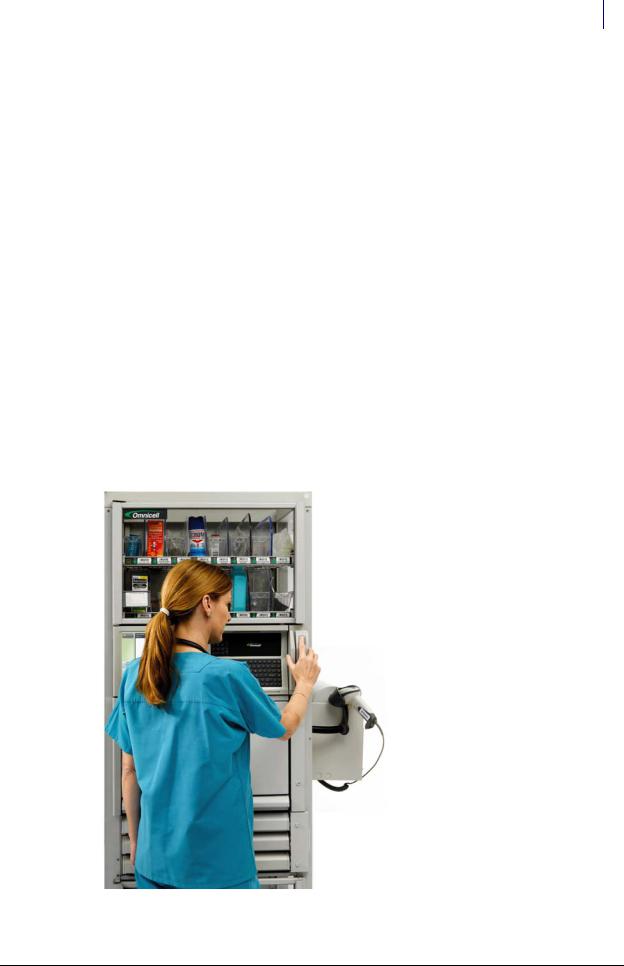
1-1
Introduction to Touch & Go
The fingerprint scanner is a biometric, positive-ID system. A biometric system is made up of a sensor, a computer unit, and an application for which the user’s authentication is necessary. The sensor captures the biometric characteristic; and the computer unit processes and eventually saves the biometric data.
The identification of users in a computer system is often done through the use of an ID and password. IDs and passwords are capable of being forgotten, shared, or stolen. Biometric systems, such as Omnicell’s biometric fingerprint system, use personal features of the user to check identity. Biometric systems can be particularly important to hospitals trying to keep medications and clinical information secure from inappropriate access. Fingerprint recognition is the most common form of biometric identification.
When effectively implemented, Omnicell’s biometric fingerprint system offers high security and fast access to the Color Touch cabinet. It provides a more secure access because there are no lost or stolen passwords. Also, no one can replicate or “hack” a fingerprint image. Some state regulations require positive user identification and fingerprint scanning helps to meet this requirement. It provides a more rapid access to cabinets because it requires less key strokes than typing a password. The cabinet uses this hardware for both verification (authentication) and enrollment of user fingerprints.
Figure 1-1. Touch & Go, One-cell OmniSupplier
© 2011 Omnicell, Inc. |
Touch & Go™ Technical Guide for UPEK Sensor Model/67-3090 Rev A |
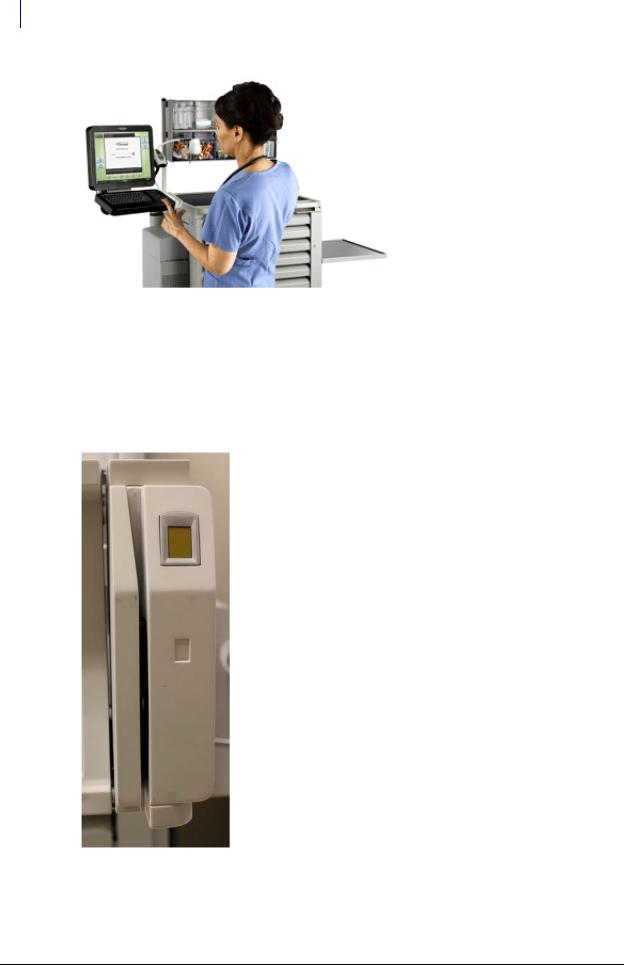
1-2 Introduction to Touch & Go
Hardware Overview
Figure 1-2. Touch & Go Anesthesia Workstation
Hardware Overview
Omnicell cabinets that are ordered initially with Touch & Go are shipped with the feature installed from manufacturing. However, cabinets can be retrofitted for Touch & Go at the customer facility.
The Touch & Go device contains the housing for a card reader, to the left or right of the fingerprint scanner.
Figure 1-3. Fingerprint Sensor with Card Reader
Touch & Go™ Technical Guide for UPEK Sensor Model/67-3090 Rev A |
© 2011 Omnicell, Inc. |

Introduction to Touch & Go 1-3
Fingerprints
If Touch & Go is ordered with a card reader, the applicable reader mechanism is installed by manufacturing. If the cabinet has an existing card reader, it is uninstalled and replaced with the Touch & Go device. See “Retrofitting the Fingerprint Scanner with a Card Reader” on page 3-1.
Note: If installing a card reader by itself, without a fingerprint scanner, refer to the Card Reader Installation and Configuration Guide, PN 67-2006.
Fingerprints
Fingerprints are the result of minute ridges and valleys found on the fingertip of every person.
They are based on the ridges of skin forming a pattern that is unique to each individual. Each fingerprint has one of three core features: loops, whorls, or arches. It is the core of the fingerprint that contains the most information.
Many user issues impact the success of any biometric fingerprint system. Cuts, bruises, aging, and wearing of the skin all impact how well a biometric device scans a fingerprint. A hospital’s environmental conditions can also impact image quality by causing hands to be dry or excessively moist. Fingerprint quality varies from finger to finger and a user’s hobbies, such as gardening woodworking, or rock climbing can all impact the ability to get a good fingerprint scan. Some users may even be impacted by rare skin diseases or burns which permanently destroy a fingerprint. These specified users can remain completely exempt from biometric requirements.
Users enroll a reference fingerprint that is used for comparison at the time of login. A good enrollment is the best predictor of future successful logins.
Enrolling two fingers takes 1-2 minutes in most cases
Enrollment Rates 95% or higher observed at Beta sites
First time Login Success Rates 95% or higher
User ID + fingerprint login is the most secure
Shortlist login is very secure with a very slight possibility of a false positive ID
Fingerprint Security
Users may have concerns about identity theft or misuse of their fingerprint. Omnicell does not store or transmit fingerprint images. Fingerprint scanners work by capturing and measuring the relative position of the different core features (loops, whorls, and arches) of a fingerprint. The fingerprint is broken down into a complex pattern of unique features called minutiae. The pattern (not the fingerprint) is stored numerically.
When a fingerprint is scanned, it is processed into an encrypted, secure, numeric code and then immediately deleted from memory. The VeriFinger fingerprint technology software, built into the
Omnicell software, performs the fingerprint identification processing. The fingerprint minutia numeric code can only be used by the VeriFinger fingerprint technology software. It cannot be reverse-engineered to recreate a fingerprint image. The actual image is deleted. The only information retained is the X-Y location of the minutia points. These minutia points are used for match comparisons using the VeriFinger software. Omnicell cannot modify the VeriFinger fingerprint software, because Omnicell does not have access to the underlying VeriFinger source code.
The fingerprint security configurations of the Touch & Go product provide increased security and reduces the chance of failed identifications. These configurations allow customers to easily adjust the security and reliability of the fingerprint identification feature to meet their particular needs.
© 2011 Omnicell, Inc. |
Touch & Go™ Technical Guide for UPEK Sensor Model/67-3090 Rev A |
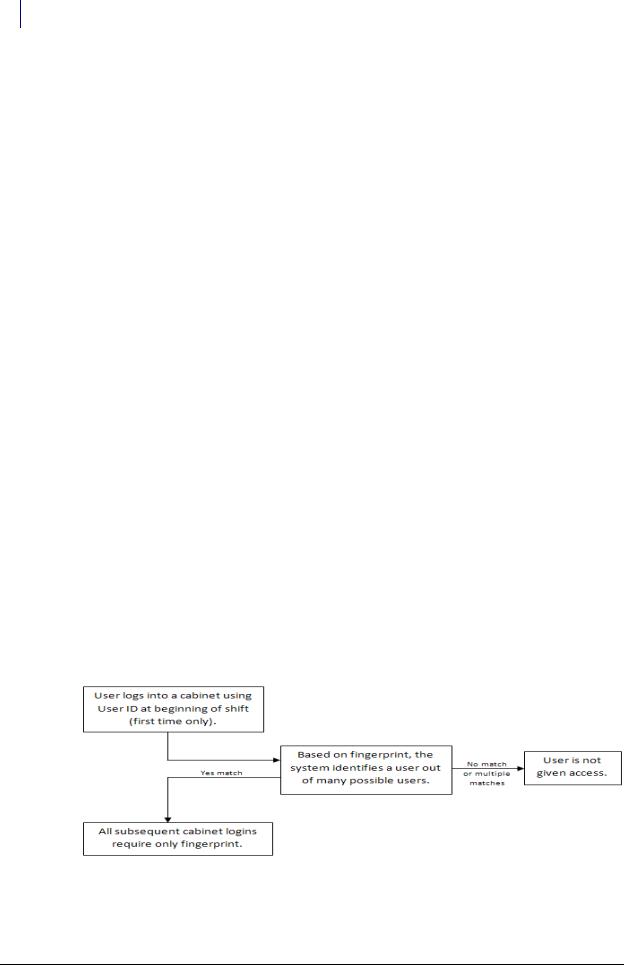
1-4 Introduction to Touch & Go
User Authentication
User Authentication
Omnicell’s biometric fingerprint system provides two functions: Identification and Verification. The identification function compares and identifies one user out of many possible users. The verification function makes sure a user is who they claim to be.
Verification, or authentication, is the process of determining the identity of a person and confirming his or her authenticity. An authentication factor is a piece of information (such as a password, User ID, or fingerprint) and the process used to verify the identity of a person. In order for a User ID to qualify as an authentication factor, only the user can know it. The user ID should be hard to obtain and not be displayed. A user ID may be entered via keyboard entry, magnetic card, or bar code.
A weak user ID is one which can be easily guessed by another user, and therefore is not considered a personally identifiable factor for authentication purposes. User names which follow a simple pattern, such as first name plus the first two letters of the last name, fall into the weak category.
A strong user ID contains information that would be known to the user but not readily known or available to other users. User names which include the last four digits of the user’s social security number or random three-digit number assigned by the system would fall into the strong category.
Omnicell has identified three user authentication modes:
Single-factor (Touch & Go) authentication
Two-factor with fingerprint authentication
Two-factor with password authentication
Single-factor Authentication Mode
The single-factor authentication mode is secure and is the most convenient. It requires a fingerprint only. This mode employs the use of the short list along with the recommended configuration settings. A short list is a list of fingerprint users within a defined window of activity.
It is a subset of the total users in the database. The length of time that a user remains on a short list is determined by user activity and configurable OmniCenter settings. After an initial user ID (with fingerprint or password) is entered on each cabinet that is accessed daily, subsequent login actions only require a fingerprint scan. (See Figure 1-4.)
If a login fingerprint matches more than one user at or above the minimum quality threshold, the system warns the user and does not allow access. These users may need to be re-enrolled with a different finger or made exempt.
Figure 1-4. Single-factor Convenience Authentication
Touch & Go™ Technical Guide for UPEK Sensor Model/67-3090 Rev A |
© 2011 Omnicell, Inc. |
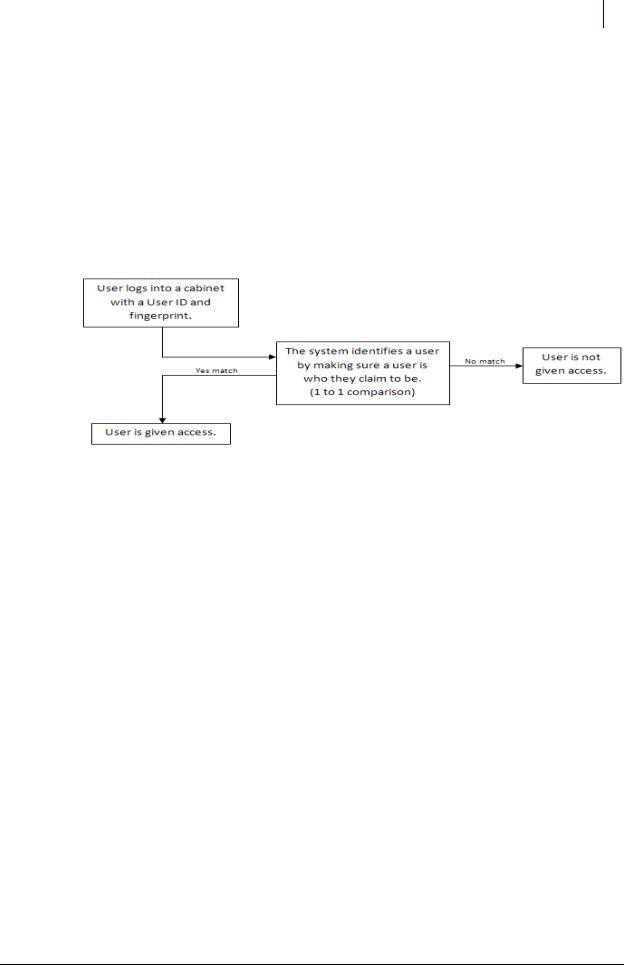
Introduction to Touch & Go 1-5
Fingerprint Enrollment
Two-factor with Fingerprint Authentication Mode
The two-factor with fingerprint authentication mode uses two pieces of information to verify identity. It requires a strong user ID and fingerprint. After the user enters their user ID and their fingerprint is scanned, the system brings up the user’s stored sample pattern. The system tries to verify that the fingerprint samples match using a one-to-one comparison. It is the most secure mode because no one can replicate or “hack” the user’s fingerprint image.
Two-factor with Password Authentication Mode
The two-factor with password authentication mode uses two pieces of information to verify identity. It requires a strong user ID and password. It is more secure than single-factor.
Figure 1-5. Two-factor Authentication
Omnicell recommends the implementation of two-factor authentication. Nevertheless, it is the customer who decides whether to implement single-factor or two-factor authentication. This decision impacts the system’s overall speed, security, training requirements, and administrative issues.
Fingerprint Enrollment
Fingerprint enrollment is performed at one Color Touch cabinet. The fingerprint template is sent to all appropriate cabinets via OmniCenter. User access, witness, and enrollment privileges are controlled within the individual user record by OmniCenter®. A user’s fingerprint verification can be used for any login or witness process.
The initial fingerprint enrollment process requires two people—the registrar and the user being enrolled. The purpose of the registrar is to oversee the enrollment of others. In order to initiate enrollment, a valid registrar must log in first. Then the user to be enrolled is guided through a two-part process to assess the scan quality of the finger and to enroll the fingerprint found to produce quality scans.
Omnicell’s Touch & Go G4 system supports enrollment of a primary and an alternate finger. This allows the user an option to use either finger to log on. If one finger becomes injured or damaged, users still have the ability to log on with the other finger.
To further ensure enrollment success, the fingerprint system follows a specific finger order. This order is consistent for initial enrollment as well as user re-enrollment.
The index fingers, middle fingers, and thumbs are found to be the most successful in terms of providing the best quality scan. The user to be enrolled can change or modify the guided workflow based on strong preference or need. Work with the user during initial enrollment to understand their unique needs.
© 2011 Omnicell, Inc. |
Touch & Go™ Technical Guide for UPEK Sensor Model/67-3090 Rev A |

1-6 Introduction to Touch & Go
Fingerprint Reports
For more information about fingerprint enrollment, see Fingerprint Enrollment in the Color Touch 15.0 Administration Guide, PN 60-0209.
Fingerprint Reports
Biometric events contain information that help system administrators manage fingerprint usage.
The information is based on events sent by a G4 cabinet. Two reports provide this information:
User Fingerprint Enrollment Report
The User Fingerprint Enrollment Report provides information about who is enrolled, which finger is enrolled, when enrollment took place, and which cabinet was used for enrollment,
User Fingerprint Activity Report
The User Fingerprint Activity Report finds out about enrollment and login activity, successes, and failures.
For more information about the report options, refer to OmniCenter 15.0 Reports Guide, PN 60-0176.
System Requirements/Compatibility
The UPEK fingerprint scanning device can only be installed on Color Touch G4 cabinets running
Windows® 7. The G3 Fujitsu sensor cannot be moved to a G4 cabinet and the G4 UPEK sensor cannot be moved to a G3 cabinet.
Important: For full functionality of all Touch & Go features, Windows 2008 is required at the server and Omnicell 15.0 is required at the cabinet.
The following are required to implement this feature:
OmniCenter running Microsoft Windows Server 2008 or higher, and Omnicell 15.0 software or higher.
Color Touch cabinets running Microsoft Windows 7 and Color Touch 15.0 or higher.
Omnicell's G4 (fourth generation) automated medication and supply dispensing solution
A UPEK Touch & Go module installed and enabled on the cabinet.
Specific cabinet types supported are:
OmniRx® Color Touch
OmniSupplier® Color Touch
AWS
The Touch & Go device can be ordered with or without a magnetic card or bar code reader. The Touch & Go device contains the housing for a card reader on the left or right of the fingerprint scanner. If ordered with a card reader, the applicable reader mechanism is installed in manufacturing. Regardless, if the cabinet has an existing card reader, it is uninstalled and replaced with the Touch & Go device.
Touch & Go™ Technical Guide for UPEK Sensor Model/67-3090 Rev A |
© 2011 Omnicell, Inc. |

Introduction to Touch & Go 1-7
User Instructions
User Instructions
Complete enrollment instructions along with usage tips are provided in the Color Touch User Guides:
Color Touch 15.0 User Guide |
PN 60-0208 Rev A |
© 2011 Omnicell, Inc. |
Touch & Go™ Technical Guide for UPEK Sensor Model/67-3090 Rev A |
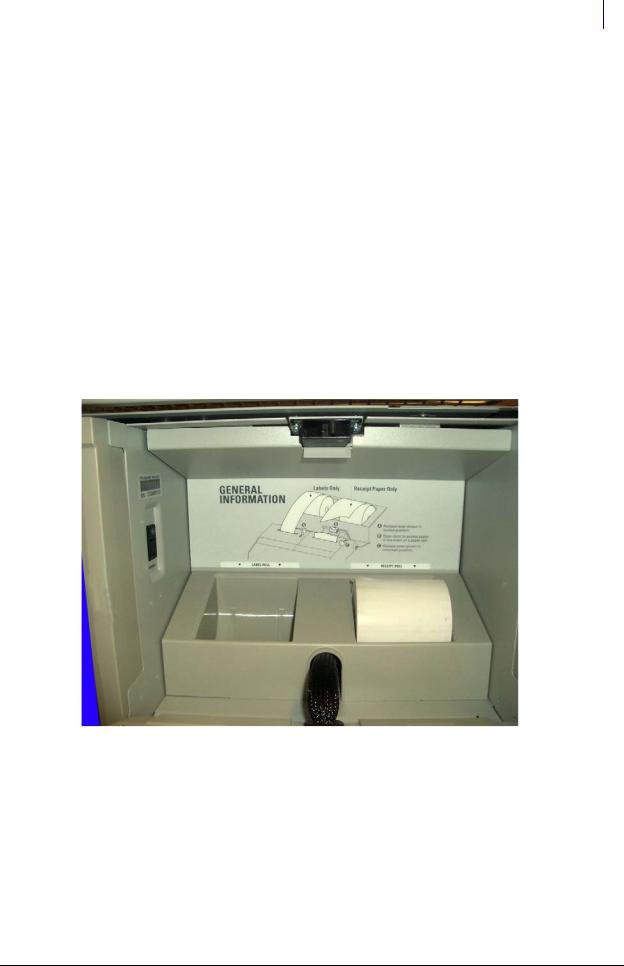
2-1
Installing a Fingerprint Scanner on a 1-, 2-, and 3-Cell
The fingerprint scanner on a 1-, 2-, and 3-cell cabinet is located on the card reader bracket and should always be installed with the card reader bracket as a single piece.
Install the Fingerprint Scanner
1.Perform a graceful shutdown of the G4 cabinet and unplug the power cord from the back of the unit.
2.Open the printer door.
3.Remove the filter access cover.
Figure 2-1. Remove the filter access panel
© 2011 Omnicell, Inc. |
Touch & Go™ Technical Guide for UPEK Sensor Model/67-3090 Rev A |
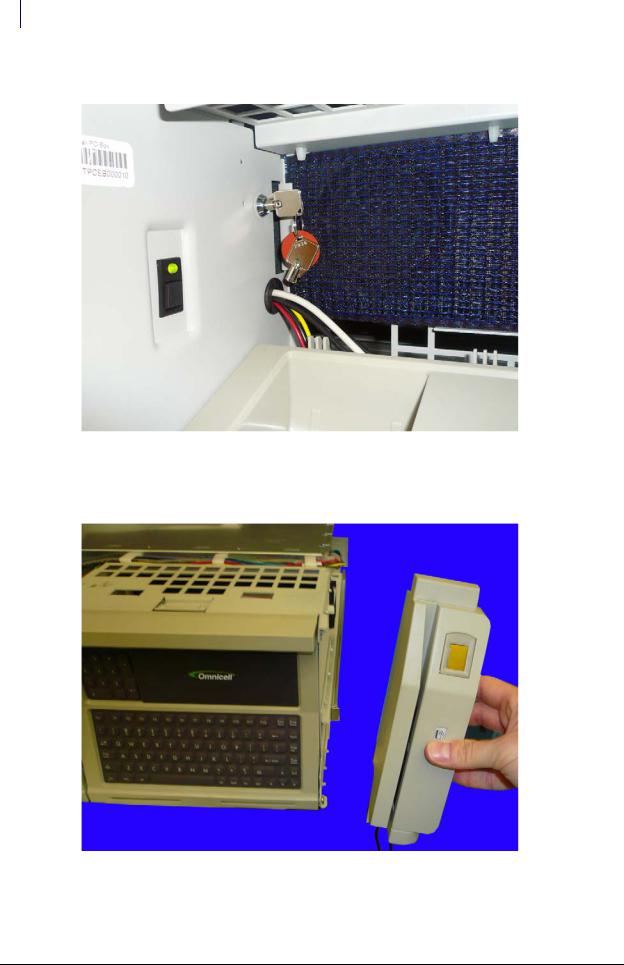
2-2 Installing a Fingerprint Scanner on a 1-, 2-, and 3-Cell
Install the Fingerprint Scanner
4. Use the # 2378 cam lock key to unlock the E-Box.
Figure 2-2. Unlock the eBox
5.Slide the console out until it locks into place.
6.Place the scanner and card reader bracket in place on the end of the eBox console.
Figure 2-3. Put the card reader and fingerprint scanner in place
Touch & Go™ Technical Guide for UPEK Sensor Model/67-3090 Rev A |
© 2011 Omnicell, Inc. |

Installing a Fingerprint Scanner on a 1-, 2-, and 3-Cell |
2-3 |
Install the Fingerprint Scanner |
|
7. Secure the fingerprint scanner bracket with the four screws provided.
Figure 2-4. Secure the scanner to the console with the four screws
© 2011 Omnicell, Inc. |
Touch & Go™ Technical Guide for UPEK Sensor Model/67-3090 Rev A |
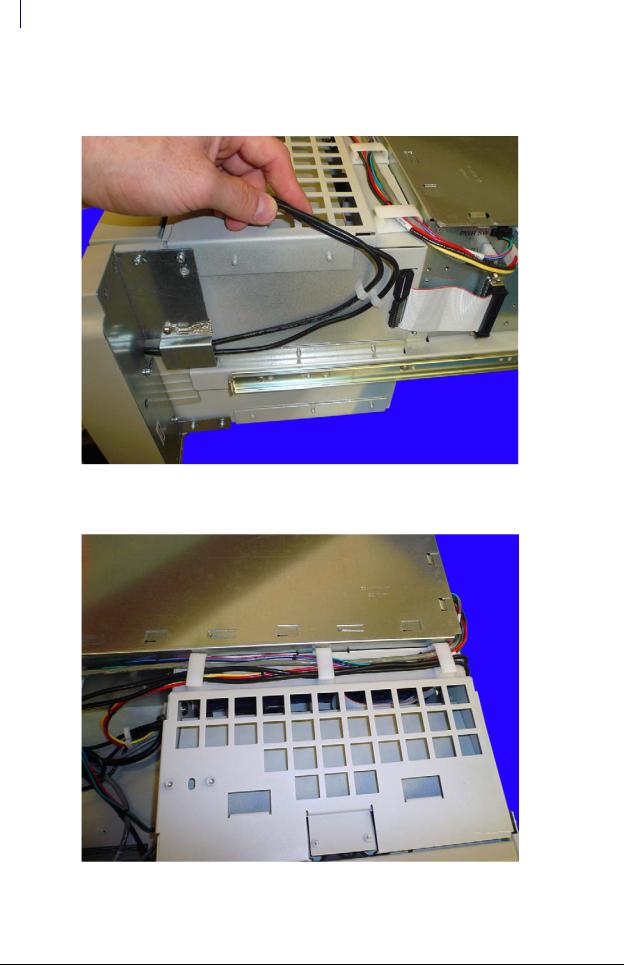
2-4 Installing a Fingerprint Scanner on a 1-, 2-, and 3-Cell
Install the Fingerprint Scanner
8.If installing a fingerprint scanner and card reader combo, route the two USB cables through the plastic cable clip provided on the side of the console. If only a scanner or card reader is being installed, route the single USB cable through the plastic clip provided.
Figure 2-5. Route the cable(s) through the cable clip
9. Route the cable(s) through the clips on the top of the eBox console.
Figure 2-6. Route the cable(s) through the plastic routing clips on top of the console
Touch & Go™ Technical Guide for UPEK Sensor Model/67-3090 Rev A |
© 2011 Omnicell, Inc. |
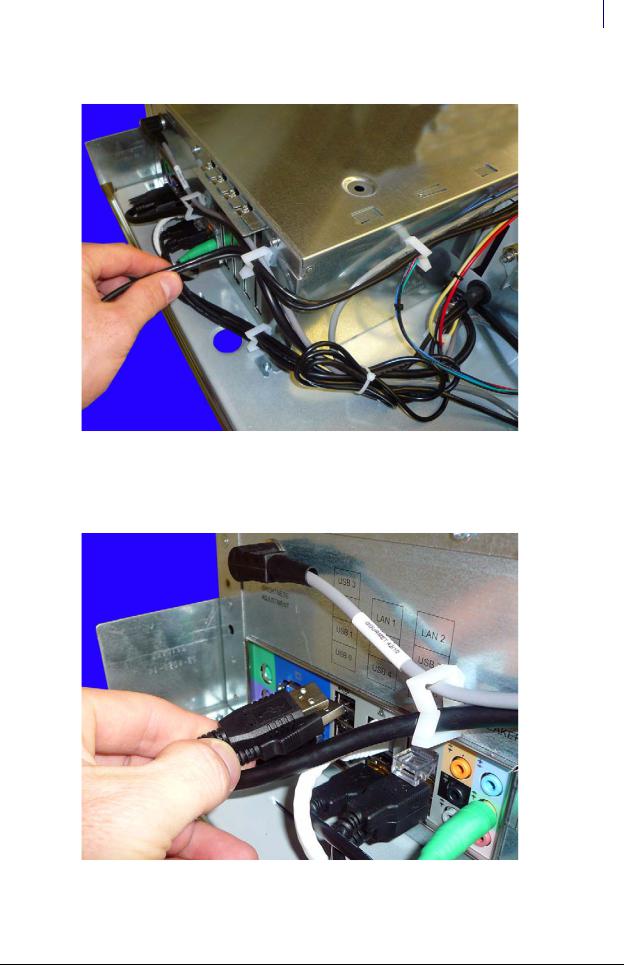
Installing a Fingerprint Scanner on a 1-, 2-, and 3-Cell 2-5
Install the Fingerprint Scanner
10. Route the cable(s) through the two clips near the USB ports.
Figure 2-7. Route the cable(s) tough the two clips near the USB ports
11.Plug the USB cable(s) into the USB ports on the side of the eBox. The fingerprint scanner USB ca ble should be plugged into USB0 and the card reader USB cable should be plugged into USB1.
Figure 2-8. Plug the USB cable(s) into the USB ports
12. Push the eBox console back into the cabinet.
© 2011 Omnicell, Inc. |
Touch & Go™ Technical Guide for UPEK Sensor Model/67-3090 Rev A |
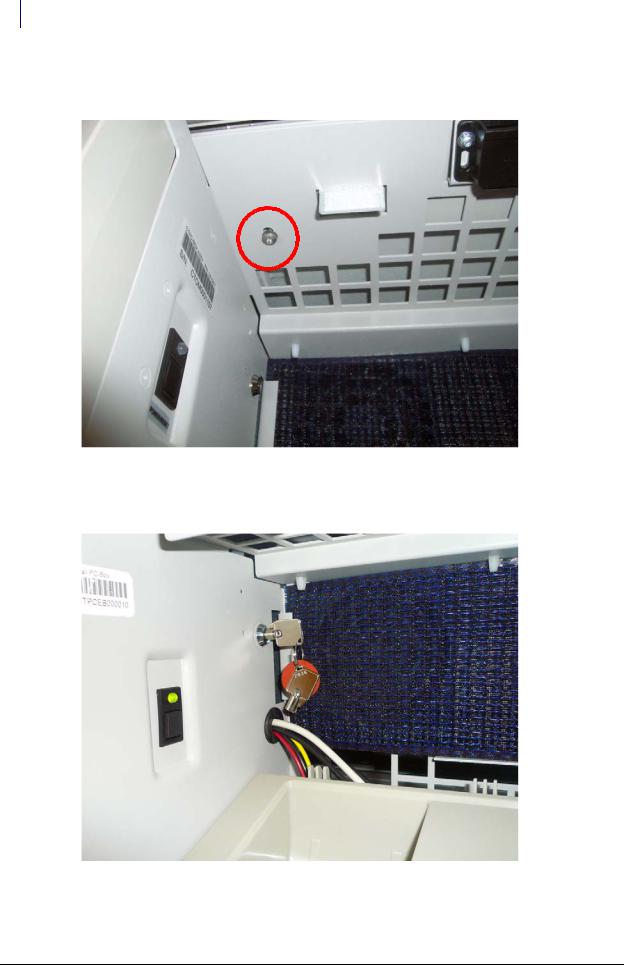
2-6 Installing a Fingerprint Scanner on a 1-, 2-, and 3-Cell
Install the Fingerprint Scanner
13.LAdd the M4x14 security screw to the top of the printer enclosure, securing it to the console cover.
Figure 2-9. Add the M4x14 security screw
14.Lock the CT PC console into place using the #2378 key. Turn the key vertical to lock the G4 console into place.
Figure 2-10. Power on the cabinet
15. Replace the filter access panel.
Touch & Go™ Technical Guide for UPEK Sensor Model/67-3090 Rev A |
© 2011 Omnicell, Inc. |
